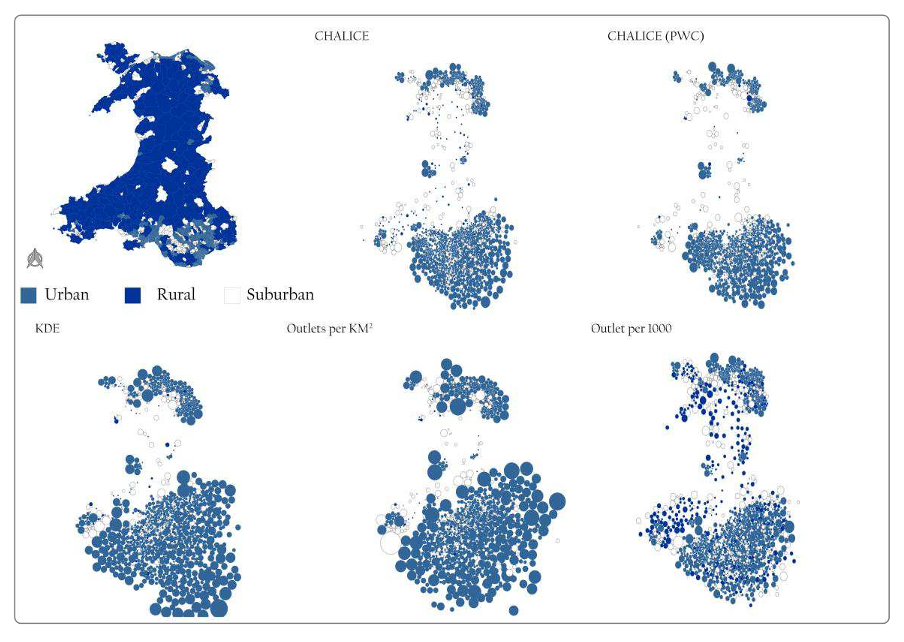




Did you find this useful? Give us your feedback















13 citations
...We will adapt a previous methodology that modelled ‘change in alcohol outlet density and alcohol-related harm to population health’ (CHALICE).(60) The distance decay for this accessibility model will be updated to emulate how people engage with GBS as opposed to alcohol outlets....
[...]
9 citations
[...]
9 citations
4 citations
15 citations
...Research has shown that omission of network routes can result in falsely assigning places as accessible (Apparicio and Seguin 2006; Higgs et al., 2012; Mizen et al., 2015)....
[...]
...…of a geographic network in analyses is an important component of measuring access to goods, services and places of interest as demonstrated by Apparicio et al. (2008), Higgs et al. (2012) and Mizen et al. (2015), which non-network approaches often resulting in significant variations in findings....
[...]
13 citations
...…with recent studies reporting on density measures from New Zealand (Cameron et al., 2015), Australia (Livingston, 2014; Morrison et al., 2015), Scotland (Richardson et al., 2015), South Africa (Leslie et al., 2015) and the USA (Brenner et al., 2015; Cederbaum et al., 2015; Cook et al., 2014)....
[...]
13 citations
...Multiple approaches have been reported in the literature (e.g. Fone et al., 2016; Grubesic et al., 2016; Richardson et al., 2015)....
[...]
...We compare the different methods, like Grubesic et al. (2016), but at a national population level and add stratification by urban–rural classifications and deprivation to investigate how the social and geographic morphologies may influence AOD measurements....
[...]
...This concurs with Grubesic et al. (2016) who found similar trends in Seattle....
[...]
...Recent work by Grubesic et al. (2016) compares alcohol access in Seattle, finding gravity model-based approaches to modelling access the most balanced approach....
[...]
[...]
9 citations
...The CHALICE method is not without limitations; the use of 10 minutes walking time to define a local neighbourhood is widely reported in the literature (Hewko et al., 2002; Langford et al., 2012; McGrail, 2012; Poelman, 2016)....
[...]
...This has been widely reported as a definition of a localised neighbourhood and used extensively in previous research (eg Jiao et al., 2011; Poelman, 2016; Reyes et al., 2014)....
[...]
8 citations
...The impact of alcohol outlet density (AOD) on health is an internationally reported phenomenon with recent studies reporting on density measures from New Zealand (Cameron et al., 2015), Australia (Livingston, 2014; Morrison et al., 2015), Scotland (Richardson et al., 2015), South Africa (Leslie et al., 2015) and the USA (Brenner et al., 2015; Cederbaum et al., 2015; Cook et al., 2014)....
[...]
..., 2015), Australia (Livingston, 2014; Morrison et al., 2015), Scotland (Richardson et al....
[...]
...…is an internationally reported phenomenon with recent studies reporting on density measures from New Zealand (Cameron et al., 2015), Australia (Livingston, 2014; Morrison et al., 2015), Scotland (Richardson et al., 2015), South Africa (Leslie et al., 2015) and the USA (Brenner et al., 2015;…...
[...]
The interactions between multi-scale AOD and health and social outcomes are an important area for future work. For example, in one of the LSOAs with a zero value there are 16 outlets within the LSOA ( but beyond 10 minutes walk of the PWC ), and a further 6 outlets in an adjacent LSOA but close enough to the boundary to be accessible. However, the authors further demonstrate that this problem is exacerbated when the results are examined over a whole country with stratification by rural-urban classification revealing over and under inflation of AOD.